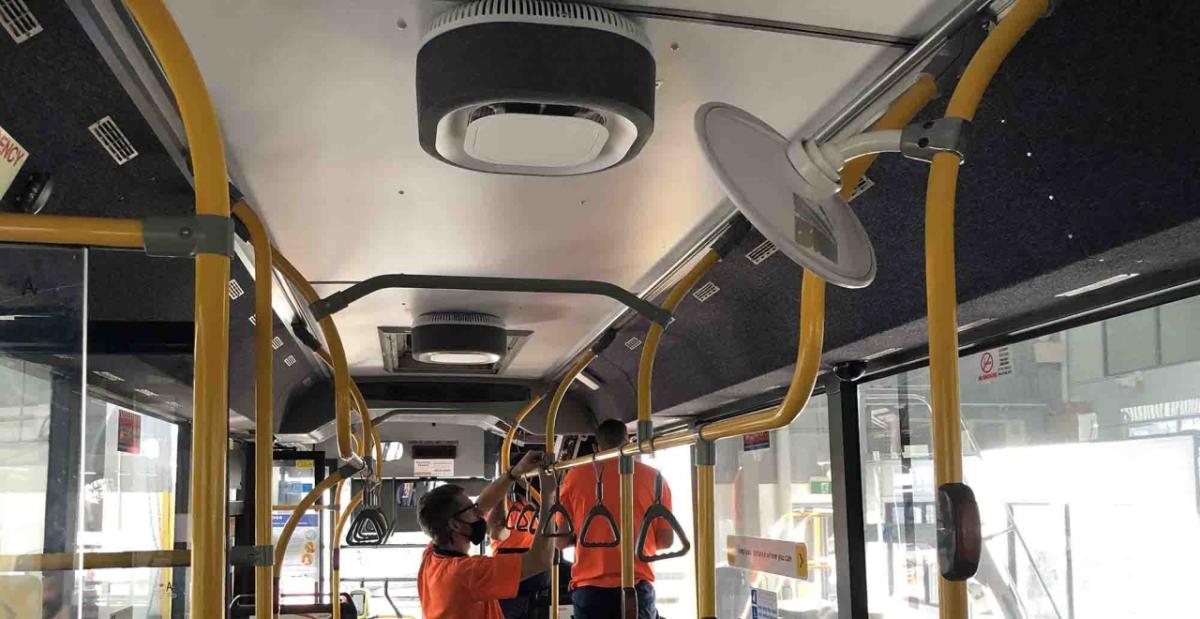Why In-Cabin Air Quality on Public Transport Matters
Learn more about why in-cabin air quality is important for transportation systems, the benefits of good in-cabin air quality and current air purification technologies available for transportation.
By Bing Bing Guo, MPH
The Impact of Covid-19 on Public Transportation
According to the American Public Transportation Association (APTA), Americans took 9.9 billion trips on public transportation in 2019. In response to the pandemic, public transportation systems experienced historic declines in ridership due to government lockdowns, the transition to remote work and public fear of contracting Covid-19 in public spaces.
However, the public transportation sector is on a path to recovery with ridership continuing to grow. In fact, from mid-February to April 2022, national public transit ridership was approximately 60 to 65% of pre-pandemic levels – significantly higher than April 2020 ridership which fell to approximately 20% of pre-pandemic levels. Despite the large decreases in ridership due to the pandemic, public transportation is a lifeline for many Americans and continues to play an essential role in ensuring people’s mobility.
While the public transportation sector has invested heavily in rigorous cleaning protocols, given that airborne transmission is one of the main transmission routes of SARS-CoV-2 (the virus that causes Covid-19), there is now an increased focus on reducing the concentration of viruses and other harmful pollutants in the air. Transit companies must work to ensure that their riders and employees feel confident, comfortable and safe when using public transportation. Investing in IAQ solutions not only helps to protect the health and well-being of drivers and passengers, but it can also increase passenger confidence, which can help increase ridership levels faster and improve employee retention rates.
Covid-19 Transmission Risks
Given mounting evidence that SARS-CoV-2 is transmitted primarily via the airborne route - there are inherent transmission risks in any enclosed setting. High-density settings such as public transportation are of particular concern, given that people are typically in very close proximity to one another.
Studies have found that smaller exhaled particles containing viral pathogens can remain suspended in the air for prolonged periods of time (up to several hours). SARS-CoV-2 and other enveloped viruses range in size from 0.06 to 0.14 microns, which is significantly smaller than particles that are captured by conventional filters typically found in trains, subways and buses.
Furthermore, it is important to note that, while regular surface cleaning continues to be important in helping to reduce viral transmission, many cleaning products may release harmful volatile organic compounds (VOCs), which can detrimentally impact human health.
How Does Poor IAQ Affect Different Modes of Public Transportation?
In addition to pathogens in the air, there are many other pollutants of concern that can significantly impact the health, well-being and overall satisfaction of drivers and passengers. In fact, the concentrations of pollutants such as fine and ultrafine particles (PM2.5 and UFPs, respectively), volatile organic compounds (VOCs), nitrogen dioxide (NO2) and black carbon in public transit can often exceed recommended levels.
While poor IAQ can impact all modes of transportation, different modes of transportation will have different exposure risks. In order to select an appropriate IAQ solution, it is important to take these differences into account.
Buses
Buses are unique compared to both buildings and other vehicles: They often idle at bus stops and open their doors, thereby allowing for outdoor pollutants, such as traffic-related pollutants, to enter the bus, which can linger once the doors are closed.
Exhaust from buses is a known source of pollution, thus raising concentrations on/near roadways as well as inside the bus cabin. Exposure to traffic-related air pollutants have been linked to increased pulmonary and cardiovascular health risks such as exacerbation of asthma, reduced lung function, myocardial infarction (commonly known as a heart attack), progression of atherosclerosis and cardiovascular mortality. Bus drivers are particularly at risk due to chronic exposure to these pollutants and need to be protected as much as possible.
Buses typically rely on MERV filters to clean their air. However, depending on the specific type of MERV filter a bus is equipped with, its ability to filter harmful pollutants will vary. MERV-13 is the minimum recommended MERV filter rating for filtering particles the size of viruses. Unfortunately, the filters used on buses are often lower-rated.
Ventilation is also generally poorer on buses compared to other forms of transportation such as trains; some buses have ceiling vents or operable windows, but not all. One advantage of city buses that make frequent stops on their route is that fresh air comes in every time the doors open, helping dilute the concentration of potentially infectious particles. However, if the outdoor air quality is poor, this also allows harmful pollutants to enter, such as fine and ultrafine particulate matter and VOCs.
School Buses
It is important to remember that public buses also include school buses. According to the American School Bus Council, approximately 480,000 school buses transport more than 25 million American children to and from school each day. Because children are more susceptible to adverse effects of air pollution, greater exposures to pollutants during school bus commutes are of particular concern, and can carry long-term health implications such as reduced lung function, increased prevalence of asthma and potential predisposition to heart disease in adulthood. Exposure to traffic-related air pollution is also associated with cognitive impairment, which can impact academic performance and productivity.
A study conducted by the U.S. Natural Resources Defense Council (NRDC) and the Coalition for Clean Air suggests that exposure to diesel exhaust may be significantly higher for the passengers riding the bus compared to people outside the bus. In fact, the study found that children who ride a diesel school bus may be exposed to up to four times more toxic diesel exhaust than someone standing or traveling beside the bus. Additionally, the researchers also estimated that a child riding a diesel school bus might be exposed to 23 to 46 times the cancer risk considered “significant” by the U.S. Environmental Protection Agency (EPA).
Trains and Subways
In one study, researchers estimated that if a commuter spent 15 minutes on a subway platform in total every day, then the commuter’s 24-hour mean PM2.5 exposure concentration would increase from an assumed daily mean of 7.7 μg/m3 to 26.1 μg/m3. Exposure to levels of PM2.5 that exceed the World Health Organization (WHO) 24-hour PM2.5 guidelines value of 15 μg/m3 may put daily commuters and transit workers at an increased risk for heart disease, stroke, chronic obstructive pulmonary disease (COPD), diabetes, lung cancer and other health issues.
While the researchers of this study acknowledge that more research is needed, as these calculations were based on untested assumptions, their estimation highlights the risks transit workers and commuters face.
Unlike buses, the air on trains and subways is replaced at a rate of about 12 to 18 changes per hour, which is far higher than the minimum exchange rate (three times per hour) for schools recommended by the American Society of Heating, Refrigerating and Air-Conditioning Engineers (ASHRAE). However, depending on the type of filter the train or subway is equipped with, its ability to filter harmful pollutants will vary. Similar to buses, trains and subways are often equipped with lower-rated MERV filters. Furthermore, trains usually lack windows that can open to offer additional ventilation.
The Health and Wellness Benefits of Good IAQ
While public transportation, such as buses, are not commonly thought of as “indoor environments,” they are nevertheless part of it, given their closed conditions. IAQ is a crucial factor that must be considered to protect the overall health and well-being of the people inside them. The benefits of good in-cabin air quality extend far beyond Covid-19. Air purification provides an additional layer of protection against respiratory viruses (such as SARS-CoV-2) and can help improve cardiovascular and respiratory health, improve concentration, enhance productivity and boost the confidence of drivers and passengers.
Improving IAQ on Transportation Systems
Fortunately, Delos currently offers air purification solutions for the transportation sector, specifically for buses. The Aura Air is a Delos Labs approved transportation solution that has the following features:
- A clean air delivery rate (CADR) of 118 cfm for PM2.5 – given the small size of the device a CADR value over 100 cfm is considered very good.
- A pre-filter which captures large particles such as dirt, dust and hair.
- A three-layer Ray Filter™, consisting of a H13 HEPA grade mechanical filter, an activated carbon filter and smart copper fabrics, which helps capture fine particles and absorb gaseous pollutants, adds antimicrobial functionality to the filter and prolongs filter life.
- Ultraviolet germicidal irradiation (UVGI) which acts to further inactivate microorganisms such as mold, bacteria and viruses. UVGI is a mature technology with proven efficacy to inactivate airborne pathogens, including SARS-CoV-2.
To learn more about different air purification technologies on the market, what public transportation service providers and officials should consider when selecting IAQ solutions and how Delos can help, stay tuned for our Q&A with Head of Delos Labs Dr. Jie Zhao, PhD.
Breathe Easier, Even When You’re On The Move
The pandemic has further emphasized the importance of the quality of air that we breathe in enclosed environments. There has never been a better time for the public transportation sector to invest in cleaner air.
Contact a Delos representative today to further discuss our findings and see how you can best help protect the health, safety and well-being of your drivers and passengers.
View original content here



